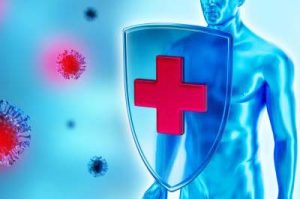
Every person is unique!
Our experienced team will be happy to advise you in detail and free of charge on all matters relating to your health. Book your consultation appointment now:
Polysaccharides and glycoproteins
April 16, 2022
Dr. Dorothee Bös et al.
Polysaccharides are also called glycans and, as polysaccharides, are a subgroup of carbohydrates. Depending on which individual sugars they are composed of, they have different names. The following eight essential individual sugars are the building blocks for polysaccharides: glucose, galactose, mannose, fucose, xylose, N-acetylglucosamine, N-acetylgalactosamine, and N-acetylneuraminic acid.
One subgroup, proteoglycans (mucopolysaccharides), is an important component of the extracellular matrix and cell surface. Proteoglycans have a high water-binding capacity. They are characterized by a high polysaccharide content of 80 to 94 percent and a low protein content of six to 20 percent.
Protein-bound glycans act more effectively on the immune system than pure polysaccharides. Studies nowadays focus on ß-1-3 and ß-1-6 glucans. These are polysaccharides from glucose with a special chemical structure. Depending on which plant or mushroom contains them, they have specific names: Lentinan from shiitake (Lentinula edodes), pleuran from Pleurotus ostreatus, grifolan or D-fraction from maitake (Grifola frondosa).
Occurrence in nature
Examples of polysaccharides are glycogen (storage sugar in humans, animals and in stand fungi), starch (storage sugar in plants), cellulose and chitin. They serve as important reserve substances and nutritional basis.
The ß-glucans are found in algae, oats, wheat or yeasts. However, the greatest variety of the particularly valuable ß-glucans is contained in particular in mushrooms. In addition to the ß-glucans, which have already been well investigated in studies, there are also many other biologically active polysaccharides in fungi. Plants contain mainly ß-1-4 glucans with a molecular weight of 45,000-50,000 daltons. ß-glucans in mushrooms have a weight of 1.5 – 2 million daltons. This is a plus, because it is believed that a high molecular weight has a better and more complex effect on our body. In addition, the fungal fruiting body has been found to contain a higher total amount and a greater variety of polysaccharides than the mycelium. The concentration of polysaccharides depends on the stage of development of the fruiting body. The increase in polysaccharide activity also increases with development and growth of the fungal fruiting body.
Features
Polysaccharides have a very high potential in terms of changing their chemical structure and thus a very high capacity to convey biological information. This allows enormous flexibility, which is important for influencing precise regulatory mechanisms in higher organisms. For example, while only 24 oligopeptide configurations are possible with four peptides (proteins), more than 1,000 different oligosaccharide configurations are possible with four carbohydrate molecules.
There are many ß-glucans from fungi, the detailed structure of which has not yet been conclusively investigated. To be effective, the ß-glucans appear to need to have ß-(1-3) or ß-(1-6) linkage. The more complex their structure and branching, the more complex they seem to act on the human body.
Vitamin C changes a high molecular weight to a low one. This leads to better absorption in the intestine and blood. A research study by Rice showed that intestinal uptake of ß-glucan is an active process that depends on gastrointestinal macrophages.
Experiments with labeled ß-glucans have shown that they are detectable in lymph nodes and spleen three days after ingestion and in bone marrow four days after ingestion. In all cases, they are detectable within macrophages. In the first three days after oral ingestion, the ß-glucans do not cause any change. They are then broken down within 14 to 21 days. The resulting fragments are biologically active, released to the outside and picked up by CR3 at the granulocyte membrane as early as day four. There they develop their function of stimulating the immune system.
Depending on the degree of polymerization, there are soluble – these have a stronger immunostimulatory effect – and insoluble ß-glucans. The more branched they are, the more likely they are to be water soluble. The polysaccharides with a low molecular weight are also soluble in alcohol.
The relationship between chemical structure and effect
In Japan and China, some of the polysaccharides from mushrooms have passed Phase I, II and III clinical trials. However, the size and complexity of their structure make it difficult to study the exact mechanisms of action. There is disagreement as to whether and to what extent the chemical structure (branching, molecular weight) has an effect on the mechanisms of action in the body. Data on the relationship between chemical structure and effect are highly variable and contradictory.
On the one hand, high molecular weight polysaccharides (800,000 daltons) are reported to have influence on a variety of immune functions, but that after the size is reduced by heating, the range and strength of the effect is also proportionally reduced. Studies in vitro have shown that high molecular weight ß-glucans can directly activate leukocytes. According to Fadok et al. ß-glucans with a high molecular weight also increase the ability of macrophages to recognize and destroy apoptotic cells. Biological activities in vivo have also been demonstrated for ß-glucans of intermediate or low molecular weight. However, their cellular effects are less clear. ß-glucans with a very low molecular weight (5,000 – 10,000 daltons), on the other hand, are inactive.
Also, elsewhere one finds evidence that denaturation reduces cytokine-induced activity of monocytes and that effects are lost by purification of single substances. Other statements postulate that it is not certain that a high molecular weight generally works better. This varies depending on the starting substance, he said.
As long as it is not clear which isolated polysaccharide is the most effective, polysaccharides should therefore be used in the form in which they are offered to us by nature: Unpurified, undenatured and as a combination of the most diverse chemical structures. This is also confirmed by several studies – Ghoneum et al., 1995; Wedam and Haynes, 1997; Sawai et al., 2002. All of these studies show that a mixture of different polysaccharides can increase the immune system is more strongly influenced.
The effect on the immune system
The ß-glucans resemble the polysaccharide chains on the outer cell wall of bacteria. This simulates the penetration of pathogens and trains the defense system. ß-glucans are not synthesized by the human organism. Therefore, the immune system recognizes them as foreign to the body, so they stimulate both innate and acquired immune responses.
To put it more precisely: ß-glucans have similar molecular properties to pathogens. They are therefore recognized by certain cell surface receptors and trigger an immune response. These receptors are dectin-1, the complement receptor, the scavenger receptor, LacCer (lactosylceramide), and the TLR (toll-like receptor). These are the receptors through which ß-glucans mediate their effect.
 Dektin-1 is a lectin and is found on macrophages, neutrophil granulocytes, dendritic cells, and T cells. ß-1-3- and ß-1-6-glucans bind to it. This binding leads to the activation of phagocytosis, which stimulates the production of ROS, TNF-alpha, IL-2, IL-10, and IL-12.
Dektin-1 is a lectin and is found on macrophages, neutrophil granulocytes, dendritic cells, and T cells. ß-1-3- and ß-1-6-glucans bind to it. This binding leads to the activation of phagocytosis, which stimulates the production of ROS, TNF-alpha, IL-2, IL-10, and IL-12.
The complement receptor is found on neutrophil granulocytes, monocytes and NK cells. ß-glucans and numerous pathogens bind to it. This triggers a cytotoxic effect on tumor cells.
The scavenger receptor is found on endothelial cells and myeloid cells (monocytes, granulocytes). LDL, HDL, various exogenous cells and lentinan bind to it. This activates various kinases and eNOS.
LacCer on neutrophil granulocytes leads to ROS formation; LacCer on epithelial cells to the synthesis of TNF-alpha and NF-kappa B. ß-glucans and microbial cells bind to it.
The Toll-like receptor TLR is found on macrophages, lymphocytes, dendritic cells and epithelial cells. It reacts to fungi, bacteria, viruses and protozoa, producing NFkappa B and cytokines (TNF-alpha, IL-12).
The effect on the innate nonspecific immune response is to increase cytotoxicity and cytokine production by macrophages, natural killer cells, and neutrophil granulocytes. They also act against degenerate cells, viruses and bacteria through the production of free oxygen and nitrogen radicals (NO gas).
The effect on the acquired immune response is the activation of dendritic cells. These are derived from monocytes and present antigens to T cells. ß-glucans also stimulate the production of the cytokines and chemokines IL-8, IL-1b, IL-6, and the tumor necrosis factor TNF-α. Furthermore, the ability of macrophages to recognize and eliminate cells undergoing apoptosis.
ß-glucans show significant effects in animal and clinical studies. Among them, an antiviral effect in HIV (CD4 cells increase), hepatitis B (stimulation of phagocytosis) and swine flu virus (decrease of viral nucleic acids in infected animal cells, the increase of interferon gamma and NO gas), and generally an antibacterial and antifungal effect. Wound healing is also supported by increasing the activity of macrophages.
In addition, a direct cytotoxic effect on cancer cells by polysaccharides was discovered. Thus, both carcinogenesis and tumor progression can possibly be halted by ß-glucans. Active polysaccharides are also dietary fibers that can absorb potential carcinogens and promote their excretion through the intestine.
Other effects of polysaccharides
ß-glucans lower cholesterol levels, although the mechanism of action is not exactly clear. One theory suggests that they cause increased secretion of bile acids, so more cholesterol is also secreted. The other theory is that the production of cholesterol in the liver is reduced under their intake.
ß-glucans can also reduce the rise in blood sugar levels after eating. The reason is that they are likely to delay gastric emptying. Animal studies also show a hypoglycemic effect after injection of polysaccharides. This is not explained by delayed gastric emptying, but by other mechanisms that have not yet been clearly explained. Most likely are changes in insulin receptors, which under their influence become more sensitive to the uptake of sugar into cells. Furthermore, a direct increase in insulin levels is discussed.
ß-glucans also have a lowering effect on triglycerides and are helpful against arteriosclerosis. Thus, their blood sugar and blood pressure controlling effect can also be explained.
DO YOU HAVE ANY QUESTIONS?
We will gladly take time for you. In our free consultation we answer individually and personally all your health questions under:
Scientific studies / sources
- Smith, Rowan and Sullivan: “Medicinal Mushrooms: Their therapeutic properties and current medical usage with special emphasis on cancer treatments.”; May 2002, University of Strathclyde.
- Willard, Terry: “Reishi-The miracle mushroom of the ancient Chinese”; Wilhelm Heyne Verlag, 1999
- Ivo Bianchi, MD: “Modern Mycotherapy”; Hinckel Druck, 2008
- Chen, Jiezhong, Seviour Robert: “Medicinal importance of fungal ß-(1-3), (1-6)-glucans”; Mycological Research III (2007) 635-652, Elsevier.
- Hobbs, C.: “Medicinal Mushrooms”; Botanica Press, 1995.
- Halpern, G.M.: “Healing Mushrooms. Effective Treatments for today’s illnesses”; Square One Publishers, 2007.
- McAnalley B.H., Vennum E.: “Introduction to glyconutrients”, Glycoscience & Nutrition”; Vol.1 No.1, January 2000.
- Elmar W. Weiler, Lutz Nover: “General and Molecular Botany”, Georg Thieme Verlag, 2008
